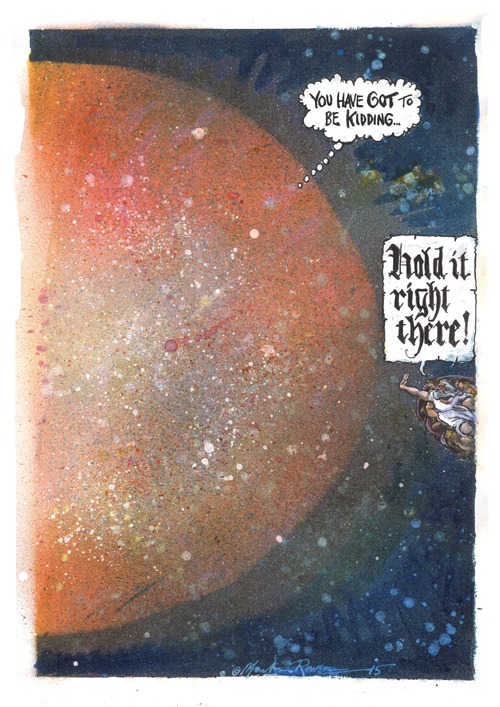
This article is a preview from the Winter 2015 edition of New Humanist. You can find out more and subscribe here.
On 10 August 2003, Brogdale in Kent saw the hottest day ever recorded in Britain. Temperatures reached 38.5C. A legion of creamy-white bodies set off for the beach. Railway lines “buckled” in the intense heat; commuters endured long delays. Compared to continental Europe, Britain got off lightly: that summer was the hottest recorded since 1500, a rise in temperature that may have contributed to 20,000 deaths. River flows and lake levels dropped to the lowest in decades, forest fires were rife and the European Alps melted.
We’re likely to see more extreme weather events as the impact of human-made climate change becomes increasingly apparent. Swift, global action now could avert disaster in the next century. But should humanity survive into the distant future, a greater challenge awaits: in 1.1 billion years’ time, the average surface temperature on Earth will rise from 20C to 75C. Why? Because the Sun is dying.
The Sun appears constant and unchanging, but this is an illusion. Our star’s struggle between its own gravity and pressure has been ongoing for billions of years. Right now, the Sun’s rates of expansion and contraction are at equilibrium – the Sun is just about managing to use its gravity to hold itself together, counteracting the internal pressure that wants to blow it up. But this won’t last for ever.
Like any other star, the Sun will eventually die. It’s not big enough to go out with a bang, in a supernova. Instead, it will probably turn into a red giant, engulfing Mercury and possibly Venus and Earth, too. But what exactly will this process look like? The laws of physics allow us to sketch out a timeline.
The Sun today: 4.6 billion years old.
Currently, the Sun has about 5 or 6 billion years’ worth of fuel left. It is mostly made up of hydrogen, which is steadily being converted into helium in the core by a process called nuclear fusion. This reaction generates energy, an obscene amount. The energy emitted per second by the Sun is approximately 3.8 X 10^26 joules. That’s enough to meet our current energy demands for the next 500,000 years.
The Sun is big. Really, really big. Our solar system contains eight planets, some 150 moons, five dwarf planets, millions of rocky asteroids and billions of icy comets. But the Sun holds 99 per cent of its mass. You’d have to take a million Earths and roll them into a ball to get the size of the Sun. The Sun is the giver of light, heat and energy. It holds the solar system together. It’s why we’re here.
The temperature in the core is 15 million degrees Celsius and the pressure is 250 billion times that of the atmospheric pressure of the Earth. Even so, the Sun’s core isn’t yet hot enough to convert helium into carbon in a reaction called the “triple-alpha process”. The build-up of helium “ash”, which is twice as heavy as hydrogen, weighs on the Sun’s heart. As a result, pressure increases, along with the Sun’s temperature and brightness.
5.7-8.1 billion years old.
At this point the Earth is in trouble. Just over a billion years from now, the Sun will be 10 per cent brighter, raising average terrestrial temperatures to around 75C. This is bad, really bad. The Earth’s atmosphere, including the stuff you need to breathe, will have gained enough energy to dart off into space, where it’s cooler.
Eventually, the oceans will vaporise. The thing is, water vapour is a brilliant greenhouse gas, and a positive feedback loop begins: water vapour traps heats, which creates more water vapour, and so on. Assisting the Earth’s suicide mission is the Sun’s ultraviolet radiation, splitting water vapour into oxygen and hydrogen to allow it to float off into space.
As sunlight hits the carbonate rocks on the ocean floor, they will release carbon dioxide, a notorious greenhouse gas. The Earth will heat up even more, and the amount of carbon dioxide released will create a rich, dense atmosphere, akin to present-day Venus. This air will be lost over millions and billions of years. Eventually the Earth will be stripped of an atmosphere, leaving a wasteland scarred by deep empty basins where oceans once lay.
10.9-11.6 billion years old.
Earth as we know it is done for, while the Sun’s core is now almost entirely helium. It starts to collapse under its own weight. As the core shrinks and the mass of the Sun sitting on it squeezes it down further, it becomes hotter and denser, and the hydrogen shell immediately surrounding the core will be hot enough to fuse hydrogen into helium, adding extra heat. The heat from inside will cause the outer layers to expand, increasing in diameter by 50 per cent, and doubling in brightness. This makes it a “sub-giant” star.
Over the next 700 million years, the diameter will grow further still, but the brightness will remain relatively constant. The Sun will start to cool down a bit. Its colour will change from yellow to orange because, although more energy is being radiated, there is more surface area for it to be radiated from. Each square inch of the Sun will emit less energy than before and a more orange colour is a visual sign that light has less energy.
11.6-12.233 billion years old.
The sub-giant is still contracting and heating up. The hydrogen around it is burning in a thin shell, adding more helium ash to the core. At this point something bizarre, known as degeneracy, happens to the Sun’s core.
According to quantum mechanics, when matter is compressed into extremely dense states it increases in temperature rather than pressure. As the core heats, the outer layers will expand to vast proportions. The Sun will fatten to 100-150 times its current size. Its surface temperature will drop by half, and its brightness – the energy it emits per second – will increase to 2,400 times its present rate, with the colour darkening again. The Sun is now a “red giant”.
Several new things happen. The Sun’s spin almost grinds to a halt – when something expands, it slows down: picture a figure skater slowing his spin when he stretches his arms – and the surface gravity drops. The gravity felt on the surface of an object depends on its mass and radius. When the Sun expands into a red giant, the mass stays the same but the radius increases 100 times, causing the surface gravity to drop by a factor of 10,000. It will be as though somebody switched off the gravity and turned on a massive fan: more than a quarter of the mass of the Sun’s outer surface will literally blow off in what is called stellar wind.
The solar system you learnt about in school won’t be the same again. Like a galactic game of Pac-Man, the Sun chases after the planets: while its size increases, its falling gravity will allow the planets to expand their orbits. Who will escape? Mercury won’t stand a chance. Venus might, but it won’t escape unscathed. Astronomers aren’t certain about Earth, but its surface temperature is likely to be around 1,370C. Rock, metal, everything will melt. If there were any living things around, even microbes burrowed deep into the Earth, they’re long gone.
***
What about us? Will humans, should we survive this long, be able to do anything about it?
By the time the Sun becomes a red giant, Mercury, Venus and Earth can be crossed out as possible homes. Mars will be too hot for us. As will Jupiter, where the average temperature will be 260C hotter than your kitchen oven. Uranus and Neptune will be too warm, as will their distant moons. We’ll need to be 7.2 billion km away from the Sun to get temperatures near to those on Earth now. The only place suitable will be the icy bodies currently orbiting the Sun well past Pluto. They will be massive puddles of water, stretching around 100km across. Luckily, these objects are said to be loaded with organic chemicals. Could we build mini Earths around the outer solar system?
It will take several million years for the Sun to turn from sub-giant to giant – time we could utilise. To live comfortably on Earth when the Sun starts to die, we need to move the Earth away from the Sun. This sounds crazy: the Earth weighs 6 sextillion, 588 quintillion tons. That’s a lot to push. It would take the amount of energy the Sun emits in a year to move the Earth to Saturn’s current orbit.
One way to get this energy would be to give spacecraft a boost of energy by essentially stealing it from the orbital motions of other planets. This is called the slingshot effect – it’s free and has virtually no impact on the environment. If we want to move a planet away from the Sun, we’ll have to send a probe in “ahead” of a planet – the probe loses its energy and the planet gains it. Even better, instead of a spacecraft, we’ll use an asteroid strapped to a solar thermal rocket.
Asteroids are much bigger and will make the energy exchange much greater (as there’s more for the energy to cling onto). So if we repeat this method about a million times, we could move away from the Sun before it kills us all. This isn’t just textbook talk; the slingshot effect has been used by many interplanetary probes. One notable example is Jupiter’s gravity giving NASA’s New Horizons the final push needed to fly towards Pluto.
Moving a relatively light vehicle is one thing, but could we really move the Earth? “To move the Earth, it would need to interact with a mass comparable to its own,” says Paul Nulsen of the Harvard-Smithsonian Center for Astrophysics. “In practice, the only likely way to find that much energy would be from the orbits of the other planets. Predicting the planets’ orbits in the long term is all but impossible, so it would be a truly gargantuan undertaking.”
***
12.233-12.345 billion years old.
By now, the Sun’s degenerate core is pure helium, contracting and heating up. The core will reach a temperature of 55 million degrees Celsius. A 2008 paper on the future of the Sun published by KP Schröder and Robert Smith argues that the Sun will eventually fuse helium into carbon. In the process, the core of the Sun releases as much energy as all the stars in the galaxy combined. This energy does not rip the Sun to shreds – it’s absorbed by the layers above the core, which means an equilibrium between temperature, pressure and gravity returns. Helium fusion can resume at a steadier pace, something like it does in our own era.
The Sun shrinks, though it will never be less than ten times its current size. Stable once again, the Sun is smaller, cooler and less bright – and will remain this way, as a helium-fusing giant, for another 110 million years. We’ll have to move the Earth back towards the Sun, doing the reverse of what we did before. In the Sun’s core, carbon and oxygen are building up. The core is too cool to fuse them so they become inert. As with helium ash, the core contracts and heats up again. Argh! Now we have to move again.
12.345-12.365 billion years old.
The helium in the Sun’s core has been converted to carbon and oxygen. The core contracts, again. The Sun will swell into a giant again, but this time it’s quicker: it takes 20 million years, not 600 million. With such a tight deadline, we’re better off bidding our goodbyes to the Earth.
The Sun will lose a further 60 per cent of its mass by stellar wind. With or without our assistance, the planets will once again move away from the Sun as it disgorges material. The downward spiral continues. The carbon-oxygen core gets so dense it becomes degenerate. A thin helium shell surrounding the core begins to burn, and a hydrogen shell burns outside that. Thin-shell helium fusion is extremely dependent on temperature. Energy released by the triple-alpha process heats the core, raising its temperature, thus rapidly increasing the rate of helium fusion.
The Sun will convulse and swell for the third and final time, this time expanding far enough to reach the Earth’s original orbit. Each convulsion will slap what remains of Earth with the force of a one-megaton bomb explosion every second for a million years. Every time it convulses, it sheds more mass, until there’s nothing left but a hot, naked core: a “white dwarf”.
12.365 billion years old.
The white dwarf, made up of carbon and oxygen, is extremely dense, bright and hot, but it’s like the fading flame on a matchstick, cooling until it eventually becomes cold ember. What’s left is a “black dwarf”, a cooled off white dwarf (for any white dwarf to reach this state, it must be older than the universe, so no black dwarf exists yet – it’s just theoretical). All the planets are frozen solid, and, after a few more billion years, they will be as cold and dark as space itself.
The End?
The ashes of the Sun – in the form of gas – will be spread across the cosmos. UV light coming from the white dwarf will cause the gas to ionise and glow beautifully. These objects are called planetary nebulae. If we make it to the other side of the solar system, the view will be spectacular.
Some information in this piece is taken from Phil Plait’s “Death from the Skies! The Science Behind the End of the World” (Penguin, 2008)

